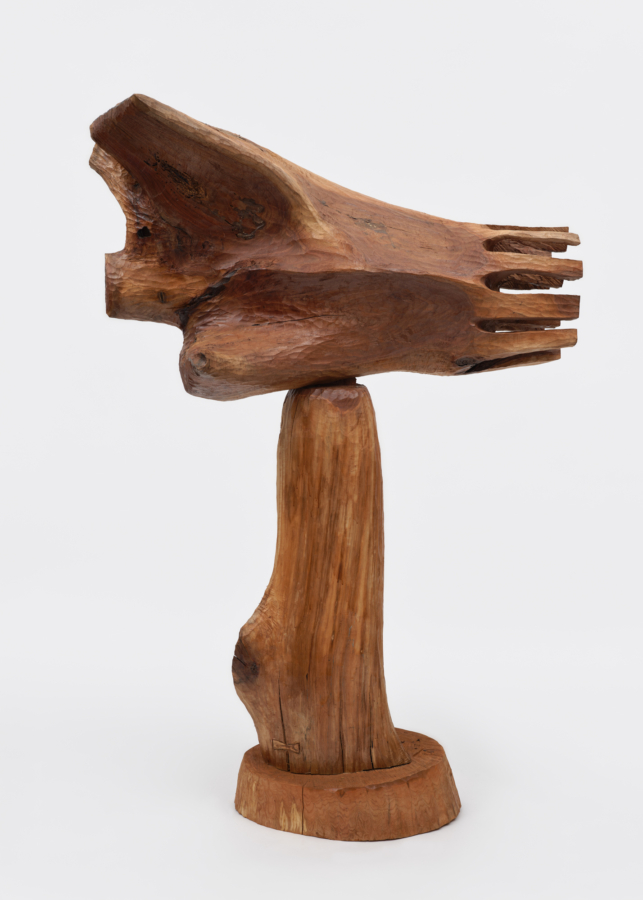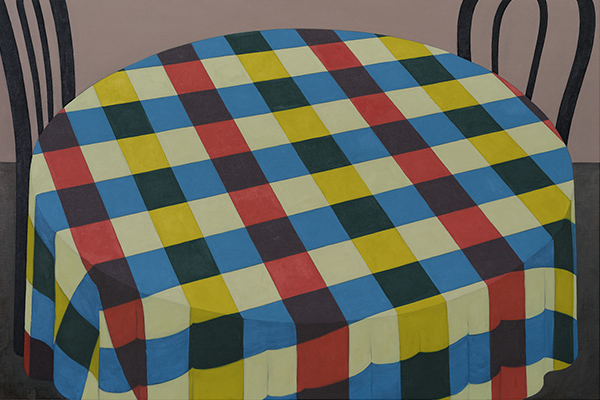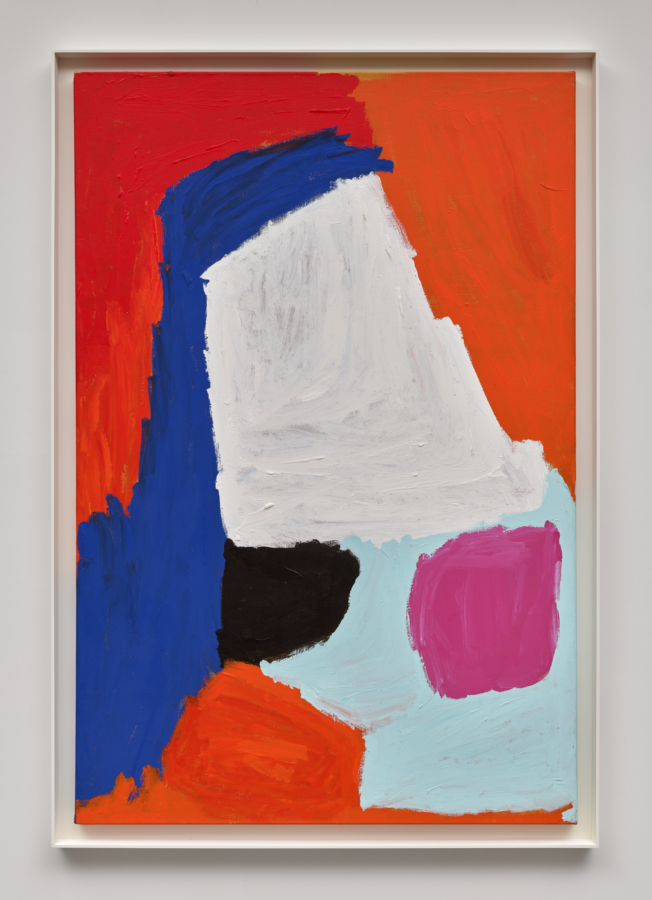February 14, 2020
Thaddeus Mosley, published by Karma, New York, 2020.
Download as PDF
Thaddeus Mosley is available here
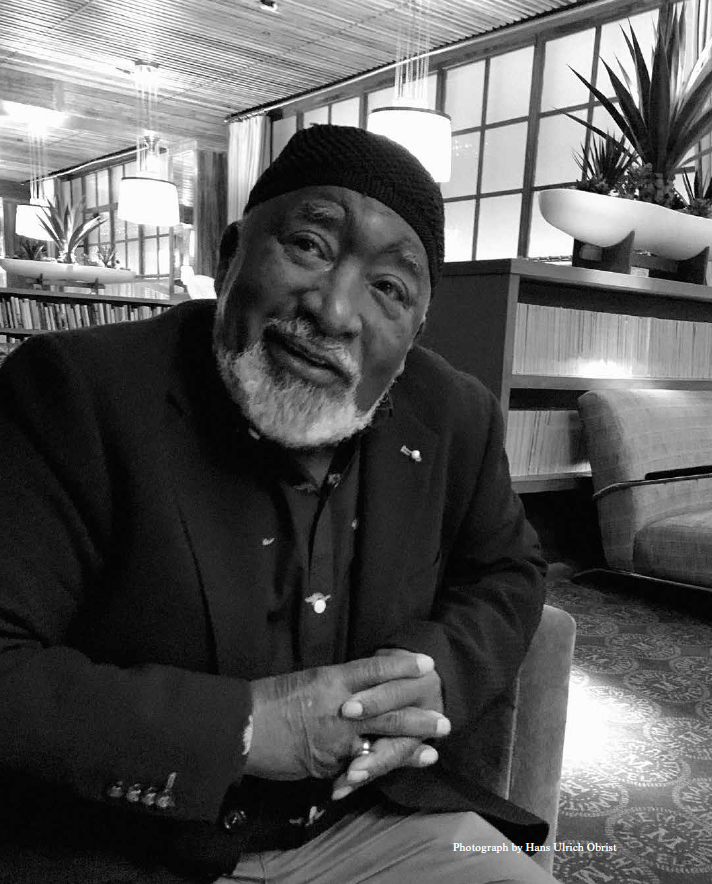
HANS ULRICH OBRIST How did art come to you?
THADDEUS MOSLEY I could draw by the time I was in elementary school. Another kid and I would draw with colored chalk on the board for nature study class. We would do various seasons: spring, winter, and so forth. The teacher left our drawings up all year until the chalk deteriorated. But I didn’t actually start looking at art until much later, when I attended the University of Pittsburgh.
HUO Have you always lived in Pittsburgh?
TM Yes. I was born in a town about 50 miles north. After the war, I went to the University of Pittsburgh, and I’ve been in Pittsburgh ever since. The university was directly across the street from the Carnegie Museum. I had a friend who was majoring in social work so that he’d have a job when he got out of school, but he was a pretty good painter. We used to go to the museum, particularly during the Carnegie International, and argue about what we thought was the best or most interesting work. I still have photos from the ‘60s of different shows there. But what really inspired me was the Scandinavian furniture that had started entering the United States in the early ‘50s. Kaufmann’s department store in Pittsburgh devoted its whole eleventh floor to Scandinavian design, and it was there that I saw for the first time really decorative furniture with details like small birds and fish made out of wood or brass. It was a way of living with art. They wanted a fortune for those pieces, so instead I thought, ‘I can make that.’
HUO You went home and you did it?
TM Yes, I just bought some two by fours and steel rods and went from there. That’s what really got me started. I was working constantly, expanding into making heads and small figures. My job as a clerk at the postal service took very little creative energy.
HUO You had a day job at the post office for many years?
TM That was my day job for 40 years. Sometimes I worked at night, so that I could work on my art during the day. I had a house on the Southside with a little building behind it that I used for a studio. That’s the reason I bought the house. It had been a whiskey still during the prohibition.
HUO I often visit Brancusi’s studio in Paris, and I understand he had a great influence on you.
TM I am into his wood carvings, like King of Kings (c. 1938), that revealed his African influence. When museums show Brancusi now, they seldom show any of his wood carvings, it’s always the cast bronze, steel, or sometimes stone.
HUO Noguchi is another artist who still inspires many artists. Danh Vo just did a Noguchi related exhibition.
TM I’ve always seen Noguchi as one of the greatest American sculptors of all time, but I never thought he got nearly enough credit or exposure. I met him a couple of times.
HUO Where did you meet him?
TM I had a friend named Jack Shepherd who did photography for Channel 11 TV in Pittsburgh. Martha Graham had just graduated from what used to be called Western Pennsylvania College for Women and was premiering Appalachian Spring (1944) in Pittsburgh. My buddy told me, ‘Now you can’t say anything, but I’m doing the photography over at the theater for Channel 11. They’re setting up the sets for the performance tomorrow, and you could help me carry the equipment.’ That’s the first time I saw Noguchi’s work because he did the sets for Appalachian Spring. Later, Leon Arkus, who was the director at Carnegie, invited Noguchi for a talk. At the talk, someone said, ‘Mr. Noguchi has agreed to shake everyone’s hand as they exit.’ I told my wife, ‘We’ll lessen the pain; we’ll go out the opposite way.’ As we were leaving in the other direction, Leon stopped me and said, ‘Mr. Noguchi wants to meet you.’ So I went over to him. We were standing in the doorway talking when he said, ‘You’re a little guy like me. I like what I saw of your work,’ and so forth.
HUO Leon Arkus was one of the first people to support your work.
TM He was one of the few people in the world who thought I was doing something different and special. He might have been the only one. The Carnegie used to have a piece of mine on the stairs when Leon was the director.
HUO What piece was that?
TM It’s called Georgia Gray. We were standing there talking about it, and everyone was looking, so I said, ‘We’re holding up to the line,’ but he said, ‘Let them wait.’ Noguchi was capable of what I would call stone poetry. He was able to join different pieces together and still make them appear light, not cumbersome or heavy. One of the most important aspects of my own work is how different segments interact. Because of Noguchi, I’ve aimed for work that levitates or is slightly off balance.
HUO With your sculptures, one can take the pieces apart, and then when they are together there is this feeling of defying gravity. They almost seem to fly. It’s fascinating, like a dance.
TM Well I hope so. Part of the reason why I use different pieces is Isamu Noguchi, Appalachian Spring, 1944–85 that it makes it easier to transport. I tell people that’s my main talent. When I first had a show at the Carnegie and the mover came to look at the work, he said ‘I don’t think I can do this job.’ I said, ‘Why not?’ He said, ‘Have you ever had any of these moved?’ I told him, ‘I move them all the time. They all come apart,’ and I showed him.
HUO They’re like a kit?
TM Yes, almost like Lego. I started making these assemblages because of a material problem. When you buy a log, you then have a large circular pole that you have to deal with. How do you make this different? How do you expand it? You bring in another log that looks different from that log, and you play out the difference.
HUO I grew up in Switzerland, so I encountered Giacometti’s work at a very young age. His long, thin figures really got me interested in art. I read in David Lewis’s book, Thaddeus Mosley: African-American Sculptor (1997), that Giacometti was a big influence on you. Where did you first see his work?
TM The Pittsburgh art patron G. David Thompson was a big collector of Giacometti. He lived out in the suburbs in a very modest neighborhood for a man with that much money. He had a Giacometti by the door and other sculptures in his yard. I used to go out there to get wood and would stop by just to look at it all. One day Thompson came out when I was there with a guy named Bat Smith. He asked, ‘Do you guys know what you’re looking at?’ and we said, ‘Yes, that’s Giacometti.’ He said, ‘None of my neighbors know what any of this stuff is, they think I’m crazy.’ The Carnegie had a lot of Giacometti as well. I don’t know if Dogon sculpture ever influenced him, but when you look at Giacometti you see the thinness of the Dogon iron sculptures. They have a beautiful movement to them.
HUO Giacometti took a lot from African art. When did you first become interested in African art?
TM I was a junior in college taking a course on world culture. Before then I had never really seen any African art. In class, they showed us a picture of an African dance sculpture and then a picture of a Brancusi. Although I had no art background whatsoever I thought both of them were very intriguing. What I like about African art is that every object is unique, nothing is repetitive. The tribal arts in Western and Central Africa have probably the most diverse sculpture in the world.
HUO You told David Lewis that, as an African American artist, you feel an affinity with African art but you also feel distinctly American. It is like having, as you said, a split personality, like reading Stephen Crane while listening to John Coltrane.
TM Your memory fades when you get old, feelings fade, but I still like to read poetry and I did get to know Coltrane.
HUO How did you meet Coltrane?
TM He came to Pittsburgh to play with Miles Davis. I had a friend who sold what they call high fidelity stereo components way back before they became widely available. My friend set up the sound system for the concert, so I met Coltrane at the show. When Coltrane came with his quartet he played two straight weeks at the Grill. We went every night. I don’t know if you know Jack Larsen?
HUO Yes, I know Jack Larsen’s textile designs from the Black Mountain College.
TM The Weavers Guild had asked him to do a show at the Pittsburgh Center for the Arts. He brought his collection of African tribal weavings and hung them across the ceiling. I forget who we had out with us that night, but someone asked him, ‘Trane, did you see these African weavings?’ Coltrane asked where, we said, ‘Way out.’ He said, ‘Can you take me?’ So we took him out to see Jack Larson’s collection.
HUO How did you meet Miles Davis?
TM I was good friends with a trumpet player named Tommy Turrentine, who was buddies with Miles. The two of them were waiting for the streetcar outside of a club downtown when I pulled up with some friends in my gold Volkswagen. I was young and I never wanted to pay for a parking garage—I always took a chance on parking in the alley and getting a ticket. When I pulled out, I saw Miles and Tommy standing there. Miles said, ‘Hey, Molly, stop, stop.’ I said, ‘We have a team, what do you want?’ Miles said, ‘Where are you going?’ I said, ‘I’m going off to hear JJ Johnson at the Crawford Grill.’ He told me that they were going there, too. Miles had a voice problem at that time and could hardly talk but he did say after he got in, ‘This sure is a little car.’ On the way we drove past the Hurricane, where Jimmy Smith was playing. Miles said, ‘Stop. Let’s see Jimmy Smith.’ We all got out. Coltrane and Cannonball were already in the club. That was the heyday of jazz in Pittsburgh.
HUO That’s amazing. Dan Graham says that we can only understand an artist if we know what kind of music he or she is listening to. What music do you listen to when you work?
TM The other day was Art Blakey’s birthday so I decided to pull out my old albums, the ones with Clifford Brown and Kenny Dorham. Then I pulled out Wynton Marsalis. Then I played some Oscar Peterson because he had a tribute to Ray Brown. Ray Brown’s birthday was not long ago. Coltrane, Miles, and Ray Brown were all born the same year, 1926.
HUO When were you born?
TM 1926. Ray Brown, Miles, Coltrane, Joe Harris the drummer—we were all born the same year.
HUO What is your secret of being ever young?
TM I think the secret is doing something, staying active, and being interested in life. People always put so much stock in holidays, but I celebrate every day. I have a birthday every day. I have good wine every night. I do what I really love every day.
HUO That’s great to hear. A lot has been said about your discipline. Besides your work at the post office and your studio practice, you also worked for the black newspaper The Pittsburgh Courier. Rumor has it that you work up to 12 hours a day in your studio.
TM At times, yes. When I heard in December 2016 that I was going to be in the Carnegie International, I had only a year-and-a-half to carve the outdoor wood pieces. At that point I was 91-92 and working eight or nine hour days. Now, I only work about six hours a day.
HUO You have said that even when you worked 12 hours a day you actually were just a mere bystander to a larger process. Does chance play a role in your practice?
TM Some people make models for everything. I knew a guy who would make models in clay that he would then carve into stone. I always thought that his models had more interest, more spirit, and more spontaneity than his stone pieces. The only way you can really achieve something is if you’re not working so much from a pattern. That’s also the essence of good jazz. What’s happening now with jazz is that everyone has become so academic, everything is so schooled out. The old jazz was a lot more spontaneous. I’ve heard artists say that they weren’t going to do something until they knew exactly what they were doing. I never know exactly what I’m doing. I think you’re always learning, always trying. To me, that is the interesting part of being an artist. When I used to teach down at Touchstone, I tried to get my students to see that and to find differences in ideas and materials.
HUO What is your teaching philosophy?
TM My idea of teaching is probably different than other teachers. There are many who say, ‘Okay, everyone in the class is going to make the same thing.’ If the class is blacksmithing, everyone would make a hook. If it’s sculpture, everyone would make a head. I didn’t do that. Instead I’d say, ‘Let’s look at logs. What do you see in this log? What would you like to make?’ My goal was to find out how they thought, and how they thought was determined by what they saw. If they were hesitant at first, I would encourage them through the more mechanical processes. I taught during the summer for almost 30 years, and I have never had a student who didn’t make something. My idea is if you think you can, you can.
HUO That’s great advice.
TM I’ve always had this idea that everyone would like to make something, whether it’s art or a fish dinner, because making something is an expression of yourself. That’s what makes art really interesting for me—I’m discovering what I can or can’t do. That idea of self-discovery and of finding out how far I’m willing to go in a certain direction or how long I’m willing to pursue an idea is very important to me. People ask me all the time, ‘What are you working on now?’ and I tell them that I’m just trying to make the same thing look a little different.
HUO What is in your studio right now?
TM Since last year I’ve made four new sculptures, and I’m just starting on another one.
HUO Do they have titles?
TM The only sculpture that has a title out of these last four is the Salute to Sunbury (2019), because it was inspired by wooden grave markers in Sunbury, Georgia. The federal government has only recently taken an interest in these unmarked slave graveyards and has tried to preserve them. I got the same feeling from looking at those Sunbury grave markers as I did from Brancusi’s Bird in Space (1923). I give titles to my pieces when I do a show because everything has to be identified and insured, but I very seldom name them when they’re first made.
HUO How do you find your materials?
TM Pennsylvania, particularly Western Pennsylvania, is known for wood. It has four or five big sawmills. I’ve bought wood from the same guy for maybe fifteen years. Sometimes I go down and look at the wood and ask him, ‘Do you have a large curvy log about eight feet long?’ and he’ll say, ‘Yes, I have lots of them, I’ll bring you one.’ Sometimes I’ll just see what he has and he’ll cut the wood to size. I tell him, ‘I need some six inch bases cut about 30 inches in diameter,’ and so forth, and he does it. He told me last year, ‘When you first started buying wood from me for sculpture there were maybe ten or twelve other people who did the same. Now you’re the only one.’ I said, ‘Those other people got smart.’
HUO You tend to use walnut, cherry, or sycamore.
TM When I first started carving, I would go to one of the city parks and cut down trees. I could get any kind of wood in the parks, but I had a hard time getting any definition from them. Over time I discovered the natural beauty of hardwoods. Walnut and cherry both have few knots and don’t check as much as something like oak. So rather than hiding the structure of the wood and the interesting forms it takes, I try to highlight it.
HUO Do you ever carve in stone?
TM I was making stone sculptures at one point, but I don’t carve stone very much anymore. I had a landscaping job putting in flagstone walkways and that’s how I learned how to cut stone. The key to carving stone is that you have to be able to read it and see where the fissures are, because if you hit the wrong angle you can take off a whole half of a block. When I was younger and stronger I could lift it and move it around, but now I can’t. And working with stone involves so much dust, you always have to wear a mask and really good eye protection. You never know where the chips are going to fly.
HUO Do you make drawings or models before you begin?
TM Sometimes. With my models or drawings, I hold them in my mind until I can almost see the piece. But with the piece I’m working on now, I just took the bark off the wood and started the first rough cut, because I can see what I want it to be. Naturally, it doesn’t always turn out the way I want. Some things get top heavy or pieces won’t fit together like I thought. Sometimes I just say, ‘Well that’s complete, I’ll go on to the next one and try to make it a little more interesting.’
HUO You have made work that responds to African-American history.
TM I have done tributes to the courage of people like Harriet Tubman. I was once down in Charleston on this plantation, and I was thinking about the plantation slaves escaping out of there at night, walking through those swamps with water moccasins and whatnot and with very little clothing or anything else. They walked I don’t know how many thousand miles to get out of slavery. Someone having the courage to do this 19 or 20 times and walking all the way up to Canada with these slaves? That blows my mind. I think my tributes are not so much about being political but about the activity of these very special people.
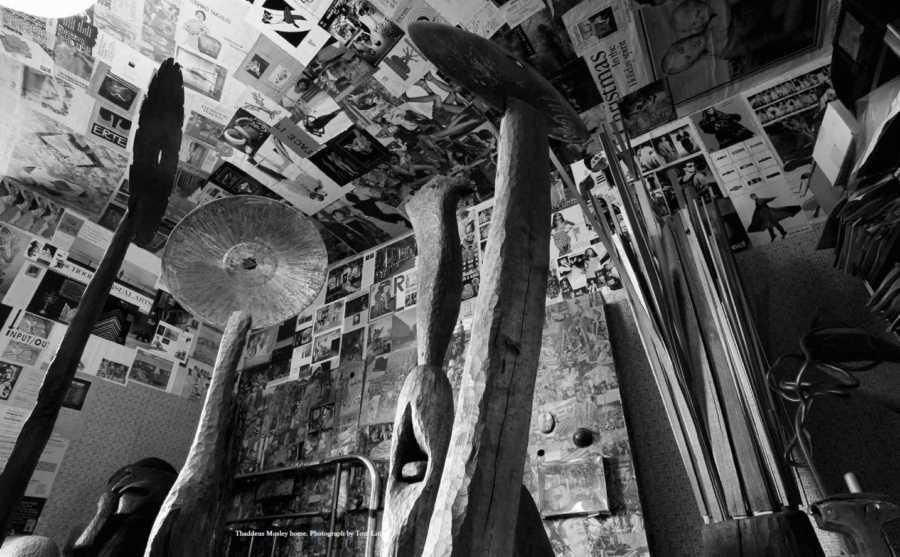
HUO In the ‘60s you were involved in the civil rights movement.
TM Yes, I was a member of the NAACP and I picketed buildings downtown with Bob Penney, Bud Brown, Nay Smith, John Simon, all these people. We would do this on our lunch hour and after work. Because I worked for the post office, I was a federal employee. One day our bosses called a group of us in and said, ‘We have all your names and pictures. If you get arrested, you’ll be dismissed.’ I had to quit some of those open protests because I was scared of losing my job. My family was depending on me.
HUO It was in the ‘60s that you had a big museum show at the Carnegie and subsequently turned down offers from New York galleries.
TM They wanted me to quit my job, to put on two shows at once. I told them no—it sounded like a rat race.That has to do with how I grew up. My children came first before anything else. You’d have to go back to my childhood to understand my reasoning. My father was a coal miner, and it was a tough job, but we lived a pretty good life. My mother didn’t want him to stay in the coal mines, so he took us back to New Castle. But shortly after, my mother and father got a divorce. After my father disappeared, our life was very difficult. Back then I made up my mind that if I ever had children, I would take care of them to the best of my ability. I’ve been lucky—I have married twice and have six children. All of them have become professional people.
HUO I’m sure Pittsburgh is glad it got to keep you. The Phoenix (1979) in the Hill district is symbolic of the ‘68 protests and has often been interpreted as being about the rise of the black community. Everybody knows it in Pittsburgh.
TM At the time, all these different people were trying to revitalize the Hill. The Phoenix was David Lewis’s project in the sense that he was the head of UDA Architects, which was working on a library in the neighborhood. David wanted to have a sculpture on the site, so he asked me to do something. We got this wild log, and I came up with the idea of a phoenix rising from its ashes out of protest. There was a lot of controversy surrounding my sculpture because some thought it was a foul symbol. A group even wanted to take it down. But it was a women’s committee who ultimately defended it successfully.
HUO Do you have any unrealized projects?
TM Not really. I like to make things that people can live with. What may still be unrealized are better ideas and better execution of those pieces. Sometimes I think they’re going to turn out better than they do, so I have to accept what I’ve done. I don’t think there is unlimited talent. At least I don’t have it. I remember I always told my students that the first art is the art of sacrifice and of learning to live with what you make. That doesn’t mean you don’t try to get better, but there is joy and sometimes surprise in that acceptance. For me, sculpture is the joy and essence of my life. Of course, it makes a lot of people listen to me because I spend so much time with myself doing what I like. But art is like a complete lifestyle—I can look at work by people I’ve never known or by my friends and I can listen to great music and I’m surrounded by this every day. This is the way I live.
Published on the occasion of
Thaddeus Mosley
February 29 – April 26, 2020
Karma
188 East 2nd Street
New York, NY 10009
Published by
Karma Books, New York
Edition of 1,000

